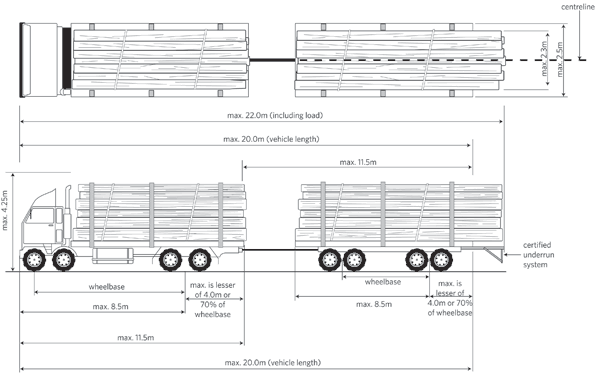
|
The axle set requirements described here apply to heavy trailers. They don’t apply to light trailers (with a gross vehicle mass up to 3.5 tonnes). |
A full trailer has two axle sets, one of which is connected to the towing vehicle by a drawbar which steers the front axle set.
A heavy full trailer must have a front axle set consisting of either:
a single axle set, or
a tandem axle set
a tri-axle set.
To improve the stability of logging trucks, an exemption is available to allow them to have two metres of log overhang past the 20 metres overall vehicle length, so that the load height would be reduced thus improving stability. This resulted in a reduction of roll-over accidents.
This overhang ‘as of right’ with two conditions:
The load overhang cannot be the full width of the vehicle. This is to aid on-road fit during cornering.
A certified rear underrun system must be fitted to reduce the risk to other motorists.

If the load overhang is within 1.15 metres of the centreline of the vehicle (up to 2.3 metres wide) it can overhang two metres up to a maximum overall length of 22 metres. A towing vehicle and full trailer combination with an overall length of more than 21 metres and a height of any substantive overhang above the ground greater than 0.55 metres must be fitted with an adjustable or removable rear underrun protection device that meets the technical requirements of UN/ECE Regulation 58: Uniform provisions concerning the approval of: I. Rear underrun protective devices (RUPDs), II. Vehicles with regard to the installation of an RUPD of an approved type, III. Vehicles with regard to their rear underrun protection (RUP). A rear underrun protection device fitted to this vehicle must be certified for compliance by a vehicle inspector or inspecting organisation.
A drawbar on a full trailer can only have one operating position and cannot be extendable unless it complies with one of the following:
It may be retractable only to facilitate the through loading or unloading of livestock or goods, provided that the drawbar has only one set of holes for locking pins and these holes are positioned so the drawbar is fully extended when locked.
OR
If the trailer is used to transport logs, the drawbar may have up to three fixed positions and one sliding position, provided that the drawbar has:
one sliding position for long logs, and
one or two fixed positions for short logs, and
a fixed position for storage of the drawbar when it is out of use while the trailer is being transported on a rigid vehicle or another trailer.
|
Note: When fully extended, the drawbar dimension must be such that the length of the trailer does not exceed 11.5 metres and the total length of the combination vehicle does not exceed 20 metres. |
A drawbeam must not be sliding or adjustable.
For a full trailer, the maximum forward distance (the distance from the rear axis to front of the trailer (excluding the drawbar and front axle set) or its load, whichever is foremost) is 8.5 metres.
For full trailers, front overhang means the distance from the centre of the turntable that connects the front axle set to the chassis of the trailer, to the foremost point of the vehicle (including its load, but excluding the drawbar). The maximum is 2.04 metres radius arc ahead of the turntable centre.
The maximum gross mass of a rigid vehicle and one full trailer in combination is 39 tonnes, unless the towing vehicle has:
a twin-steer axle set or a wheelbase of at least 4.25 metres and
at least two motor driven axles in the rear set of the truck.
In addition to these two conditions, the maximum gross mass of the heavy full trailer vehicle combination must not exceed 42 tonnes, unless:
the towing vehicle has a twin-steer axle set or a tri-axle set, or
the trailer has two tandem axle sets or the trailer has five axles.
For full trailers, inter-vehicle spacing means the distance between the towing vehicle (excluding the tow coupling shroud) and the trailer (excluding the drawbar but including the load).
The maximum is four metres. Full trailers also have a minimum requirement. The minimum inter-vehicle spacing is the greater of one metre or half the width of the foremost point of the trailer (including the load but excluding the drawbar).
The maximum rear overhang (the distance from the rear axis to the rear of the vehicle or its load, whichever is greater) for a heavy full trailer is four metres or 50 percent of the wheelbase, whichever is less. The maximum for a light full trailer is four metres.
For a rigid vehicle towing a heavy full trailer, the tow coupling position must not be further behind the rear axis of the towing vehicle than a distance equal to 45 percent of the wheelbase of the rigid vehicle. (The wheelbase is measured from the rear axis of the rigid vehicle to the foremost axle of that vehicle.)
The wheelbase of a full trailer is the distance from the rear axis of the trailer to the centre of the front axle set of the trailer.